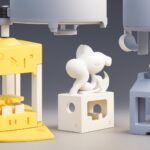Plastics,Metals, and Composites:What Can Be Used for 3D Printing?
Plastics, Metals, and Composites: What Can Be Used for 3D Printing?
The versatility of 3D printing lies in its ability to work with a wide range of materials, each with its unique properties and applications. From basic plastics to advanced metals and composites, the choice of material can significantly impact the performance and quality of the final product. In this article, we’ll explore the most commonly used 3D printing materials, their characteristics, and how they are applied in various industries.
Plastics for 3D Printing
Plastics are by far the most popular and widely used materials for 3D printing. They are affordable, easy to work with, and suitable for a variety of applications, from prototyping to functional parts.
PLA (Polylactic Acid):
Properties: PLA is a biodegradable, plant-based plastic, making it one of the most eco-friendly 3D printing materials. It is easy to print with and does not require a heated bed.
Applications: Commonly used for prototypes, decorative items, and household objects. PLA is popular in educational settings and among hobbyists.
ABS (Acrylonitrile Butadiene Styrene):
Properties: ABS is known for its toughness and durability. It requires a heated print bed and produces strong, impact-resistant parts.
Applications: Used in automotive components, electronic housings, and consumer products like LEGO bricks.
PETG (Polyethylene Terephthalate Glycol):
Properties: PETG combines the ease of use of PLA with the durability of ABS. It is moisture-resistant and has good flexibility.
Applications: Ideal for food-safe containers, water bottles, and mechanical parts that need to withstand moderate stress.
Nylon (Polyamide):
Properties: Nylon is a strong, flexible, and durable plastic, known for its resistance to wear and tear.
Applications: Frequently used in functional prototypes, gears, hinges, and industrial parts.
Metals for 3D Printing
Metals have become a crucial material in 3D printing, particularly for industries requiring high-strength, heat-resistant parts. Metal 3D printing is typically done through processes like Selective Laser Sintering (SLS) or Direct Metal Laser Sintering (DMLS), where metal powder is fused layer by layer.
Stainless Steel:
Properties: Strong, corrosion-resistant, and heat-tolerant, stainless steel is widely used in 3D printing for creating durable parts.
Applications: Commonly used in aerospace, automotive, and medical devices like surgical tools and implants.
Titanium:
Properties: Titanium is known for its incredible strength-to-weight ratio, making it ideal for high-performance applications.
Applications: Widely used in the aerospace and medical industries for lightweight, durable components like aircraft parts and prosthetics.
Aluminum:
Properties: Aluminum is lightweight, corrosion-resistant, and relatively easy to print with, making it an attractive option for many industries.
Applications: Used for automotive parts, aerospace components, and consumer electronics.
Cobalt-Chrome:
Properties: Cobalt-chrome is a high-strength metal known for its resistance to wear, corrosion, and high temperatures.
Applications: Popular in medical implants and dental applications, as well as in aerospace for turbine engines and other high-stress parts.
Composites for 3D Printing
Composites are materials made by combining two or more different substances, often to improve strength, durability, or other properties. 3D printing with composites is gaining traction, as it allows for the creation of advanced, lightweight materials with enhanced performance.
Carbon Fiber-Reinforced Polymers:
Properties: Carbon fiber composites are incredibly strong and lightweight. When combined with plastics like PLA or Nylon, they create materials that are much stronger than regular plastic.
Applications: Used in automotive, aerospace, and sports equipment for parts that need to be both strong and lightweight.
Glass Fiber-Reinforced Polymers:
Properties: Like carbon fiber, glass fiber composites offer increased strength and rigidity but are more affordable.
Applications: Frequently used in the construction industry and for producing mechanical parts that need higher durability.
Wood Filament:
Properties: Wood filament is a composite made from wood fibers and thermoplastics. It mimics the look and feel of wood while maintaining the flexibility and printability of plastic.
Applications: Used for aesthetic objects, decorative items, and furniture prototypes.
Choosing the Right 3D Printing Material
When selecting 3D printing materials, it’s essential to consider the intended application and the required properties of the finished product. Plastics like PLA and ABS are great for general-purpose use, while metals such as titanium and stainless steel are necessary for high-performance parts. Composites provide additional strength and functionality, offering a balance between lightweight and durability.
Conclusion
The range of materials for 3D printing continues to expand, offering more options for customization and performance in various industries. Whether you’re working with plastics for 3D printing, metals, or composites, understanding the properties and applications of each material is crucial for producing high-quality, functional parts.



